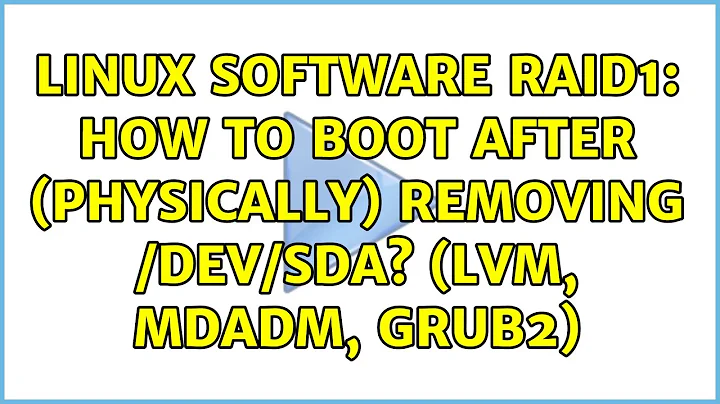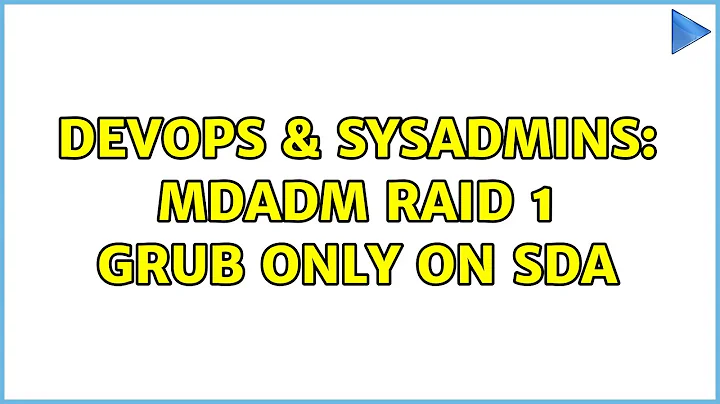mdadm raid 1 grub only on sda
Solution 1
This should be your problem
root (hd1,0)
Filesystem type is ext2fs, partition type 0x83
Take the following steps:
- Create the 2 /boot partitions on /dev/sda1 and /dev/sdb1 - type fd(Linux autodetect raid) - use your favorite tool(fdisk, cfdisk, gparted,...) (fd00 for GPT)
- Remember to turn on the bootable flag on both partitions, sda1 and sdb1 (not for GPT)
Force the disks to be a brand new raid:
mdadm --zero-superblock /dev/sda1 mdadm --zero-superblock /dev/sdb1While creating the raid metadata that will be your /boot partition, use the version 0.9. Linux cannot autodetect newer versions (without a ramdisk).
mdadm --create /dev/md0 --level=1 --raid-disks=2 /dev/sda1 /dev/sdb1 --metadata=0.9Format using ext2 or ext3
- Install your Linux of choice, WITHOUT formating the /boot
After your distro first boot:
- Fix your /etc/fstab to point /boot to /dev/md0(maybe it will not be necessary)
Install grub on the 2 disks MBR
# grub /dev/sda grub> root (hd0,0) grub> setup (hd0) grub> quit quit # grub /dev/sdb grub> root (hd1,0) grub> setup (hd1) grub> quit quitEdit your bootloader(instructions to Grub1)
Search the "default" line and add the "fallback" option bellow
vi /boot/grub/menu.lst default 0 fallback 1Add another entry to your bootloader(again, in my case i've choosen grub1 since its less complicated and it's good enough to my needs), one of each pointing to the different boot partitions that are members of the raid:
title Debian GNU/Linux, kernel 2.6.32-5-686 (default) root (hd0,0) kernel /vmlinuz-2.6.32-5-686 root=/dev/mapper/vg-root ro quiet initrd /initrd.img-2.6.32-5-686 title Debian GNU/Linux, kernel 2.6.32-5-686 (fallback) root (hd1,0) kernel /vmlinuz-2.6.32-5-686 root=/dev/mapper/vg-root ro quiet initrd /initrd.img-2.6.32-5-686Note that in my case, i have a LVM layer on my / md raid.
Done. This should be enough to you to have a "redundant" bootloader.
Solution 2
Whether you want to map those two drives onto another raid1 array is up to you. It's a legitimate choice because you would then be able to install grub to md4 directly and avoid the hustle of managing both installations manually. I've done it™.
In my experience, the device map file is largely irrelevant and its behavior (how grub reads it) is at best unpredictable, if not outright arbitrary.
The device command from the grub shell is a lot more reliable. You can read the help info on it, but the basic syntax speaks for itself:
grub> device (hd0) /dev/md4
After that, /dev/md4 will be mapped to hd0 in the currently running grub session, disregarding the device map file. From here, one would proceed as usual with root (hd0) and setup (hd0,x). The reason for installing to a partition is explained by Henry S.
AFAIK, the only thing apart from the "boot code" (stage1) that is written to the first 512 bytes of the drive (MBR) is the number of partition where that stage should look for the menu.
It's possible to mess that up. One would be greeted with a prompt instead of a menu after POST, but grub provides commands for "initializing" that menu from a different partition (file) than the once specified under installation. It generally works out without intervention though, because the "first boot drive" in bios will be detected as "hd0".
Related videos on Youtube
Backtogeek
Updated on September 18, 2022Comments
-
Backtogeek over 1 year
I just finished setting up a CentOS 6.3 64bit server with mdadm however a lightbulb went on and I realised grub would only be installed on the first drive which is about as much use and an ashtray on a motorbike.
I had a look to confirm my suspicion:
grub> find /grub/stage1 find /grub/stage1 (hd0,0)So I updated my device map to look like:
(fd0) /dev/fd0 (hd0) /dev/sda (hd1) /dev/sdb(Note the (hd1) entry was added by me
so then I tried to install grub on /dev/sdb
And I get:
grub> root (hd1,0) root (hd1,0) Filesystem type is ext2fs, partition type 0x83 grub> setup (hd1) setup (hd1) Checking if "/boot/grub/stage1" exists... no Checking if "/grub/stage1" exists... no Error 15t: File not foundSo I did some googling (Sadly google has just done a good job and picked up 100's of grub install examples which dont help here)
After finding a few clues I tried:
# grub-install --recheck /dev/sdb Probing devices to guess BIOS drives. This may take a long time. Installation finished. No error reported. This is the contents of the device map /boot/grub/device.map. Check if this is correct or not. If any of the lines is incorrect, fix it and re-run the script `grub-install'. (fd0) /dev/fd0 (hd0) /dev/sda (hd1) /dev/sdb # grub-install /dev/sdb Installation finished. No error reported. This is the contents of the device map /boot/grub/device.map. Check if this is correct or not. If any of the lines is incorrect, fix it and re-run the script `grub-install'. (fd0) /dev/fd0 (hd0) /dev/sda (hd1) /dev/sdbWhich sort of suggests grub is now installed on /dev/sdb too, however if I take another look I still get:
grub> find /grub/stage1 find /grub/stage1 (hd0,0)parted outputs for the 2 drives:
SDA
Partition Table: gpt Number Start End Size File system Name Flags 1 17.4kB 500MB 500MB ext3 1 boot 2 500MB 81.0GB 80.5GB 2 raid 3 81.0GB 85.0GB 4000MB 3 raid 4 85.0GB 3001GB 2916GB 4 raidSDB
Partition Table: gpt Number Start End Size File system Name Flags 1 17.4kB 500MB 500MB ext3 1 2 500MB 81.0GB 80.5GB 2 raid 3 81.0GB 85.0GB 4000MB 3 raid 4 85.0GB 3001GB 2916GB 4 raidAnd mdadm mdstat:
Personalities : [raid1] md1 : active raid1 sdb3[1] sda3[0] 3905218 blocks super 1.1 [2/2] [UU] md2 : active raid1 sdb4[1] sda4[0] 2847257598 blocks super 1.1 [2/2] [UU] md0 : active raid1 sda2[0] sdb2[1] 78612189 blocks super 1.1 [2/2] [UU]Is anyone able to throw some light on the situation, it feels like I am 99% there at the moment and missing something obvious.
Thanks.
edit update:
# df -h Filesystem Size Used Avail Use% Mounted on /dev/md0 74G 18G 53G 25% / tmpfs 580M 0 580M 0% /dev/shm /dev/sda1 462M 98M 341M 23% /boot xenstore 580M 64K 580M 1% /var/lib/xenstored/ is on md0 which is made up of sda2 and sdb2 swap is md1 which is sda3 and sdb3 md2 is LVM however /boot is only on /sda1
I suppose that is the problem, would the resolution be to create md4 and have it contain sda1 and sdb1
Perhaps I have things mixed up a little in my head but I assumed grub was not installed on a partition but the first few blocks of the drive i.e. sda or hd0/1
Any clarification and advice is appreciated.
-
Henry S. about 11 yearsCan you confim, that sda1 and sdb1 do contain the same files (incl. kernel, initrd, grub stages etc.), please?
-
Backtogeek about 11 yearsPerhaps the initial setup on single disk is the cause, I will update the original post with more info
-
Henry S. about 11 yearsIIRC grub would also load from a partition marked as raid. So if you create this md4, you keep the two partitions in sync. But i think you still have to run
grub-install /dev/sdXfor the separate disks. Because there is no md device at boot time. The bootfloader of grub is installed in the first blocks of the disk but the later stages are stored in the /boot _partition. Because all those fancy menues do not fit in the space before the partition table.
-
-
 244boy about 11 yearsOr, since /boot is pretty static, you could just create 2 partitions(sda1 and sdb1), sync them daily with rsync. install grub on both disks manually and use the default/fallback trick.
244boy about 11 yearsOr, since /boot is pretty static, you could just create 2 partitions(sda1 and sdb1), sync them daily with rsync. install grub on both disks manually and use the default/fallback trick. -
GeoSword almost 11 yearsRsync?!! That's a horrible idea! Let raid 1 do its thing! It sounds like the problem here is setting up raid1 AFTER the centos install has completed. Ive just finished setting up gentoo with raid 1 on the boot partition, but because raid is setup BEFORE the installation occurs, grub sees one device, and Linux RAID installs the bootloader to both disks.




